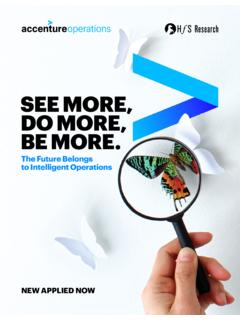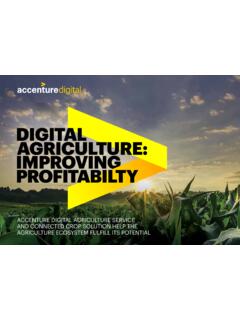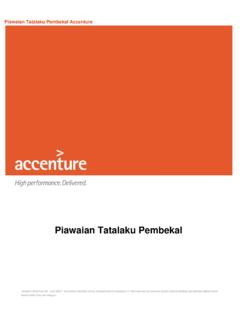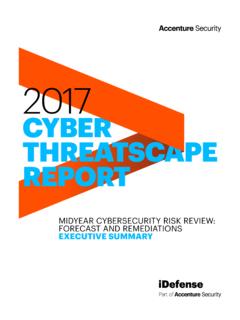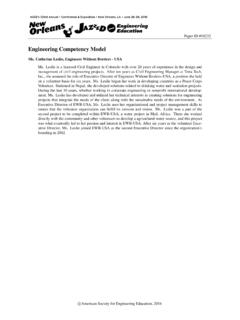Transcription of MACHINE LEARNING IN INSURANCE - Accenture
1 MACHINE LEARNING IN INSURANCEE nabling insurers to become AI-driven enterprises powered by automated MACHINE learningFSPERSPECTIVESCONTENT DATA JOURNEY SO FAR KEY FACTORS DRIVING MACHINE LEARNING IN INSURANCE UNLOCKING THE POWER OF DATA POTENTIAL FOR MACHINE LEARNING IN INSURANCE VALUE CHAIN o INSURANCE advice o Claims processing o Fraud prevention o Risk management o Other applications CHALLENGES IN IMPLEMENTING MACHINE LEARNING PROVIDING A STEPPING-STONE TO CHANGE Accenture VIEWPOINT235691112 DATA JOURNEY SO FAR Data has always played a central role in the INSURANCE industry, and today, INSURANCE carriers have access to more of it than ever before. We have created more data in the past two years than the human race has ever created. Insurers like organisations in most industries are overwhelmed by the explosion in data from a host of sources, including telematics, online and social media activity, voice analytics, connected sensors and wearable devices. They need machines to process this information and unearth analytical insights.
2 But most insurers are struggling to maximise the benefits of MACHINE LEARNING . This situation is seeing a gradual but steady change, driven by an environment characterised by increased competition, elastic marketplaces, complex claims and fraud behaviour, higher customer expectations and tighter regulation. Insurers are being forced to explore ways to use predictive modelling and MACHINE LEARNING to maintain their competitive edge, boost business operations and enhance customer satisfaction. They are also examining how they can take advantage of recent advances in artificial intelligence (AI) and MACHINE LEARNING to solve business challenges across the INSURANCE value chain. These include underwriting and loss prevention, product pricing, claims handling, fraud detection, sales and customer and advanced MACHINE LEARNING are among the top 10 strategic technology trends leading organisations are currently using to reinvent their business for a digital age. The key market forces driving the adoption of AI and advanced MACHINE LEARNING in 2018 and beyond are:1.
3 Smart everything Enterprises are looking to use advanced MACHINE LEARNING to drive smart, automated applications in fields such as healthcare diagnosis, predictive maintenance, customer service, automated data centres, self-driving cars and smart Open source everywhere As data becomes omnipresent, open source protocols will emerge to ensure data is shared and used across. Different public and private entities will come together to create ecosystems for sharing data on multiple use cases under a common regulatory and cybersecurity Harnessing Internet of things (IoT) data The volume and velocity of data from IoT will drive the need to automate the generation of actionable insight using advanced MACHINE LEARNING tools. According to Gartner, by 2020, 20 percent of enterprises will employ dedicated people to monitor and guide MACHINE LEARNING (such as neural networks). The notion of training rather than programming systems will become increasingly Ability to talk back Natural-language processing algorithms are continuously advancing.
4 AI is becoming proficient at understanding spoken language and at facial recognition, helping to make it more useful and intuitive. These algorithms are evolving in unexpected ways, as Google found when Google Translate invented its own language to help it translate more FACTORS DRIVING MACHINE LEARNING IN INSURANCE3 Figure 11000002000030000 Figure 1 illustrates the growth of the AI/ MACHINE LEARNING market in different geographical regions over 10 years. It shows the accelerating adoption of AI and the critical importance of this technology AI market, by geography 2017 2024 (in US$ M)2016 2017 2018 2019 2020 2021 2022 2023 2024 2025 2026 North America Europe Asia Pacific Rest of the world4 UNLOCKING THE POWER O F DATAMost INSURANCE companies process only 10 15 percent of the data they have access to most of which is structured data they house in traditional databases. That means they are not only failing to unlock value from their structured data, but also overlooking the valuable insights hidden in their unstructured data.
5 Analysing this unstructured data and using it to drive better business decisions requires advanced data science techniques. Emerging data analytics technologies centred on MACHINE LEARNING bring order and purpose to this unstructured data so that it can be more effectively mined for business major benefit of MACHINE LEARNING is that it can be effectively applied across structured, semi-structured or unstructured datasets. It can be used right across the value chain to understand risk, claims and customer behaviour, with higher predictive accuracy. The potential applications of MACHINE LEARNING in INSURANCE are numerous: from understanding risk appetite and premium leakage, to expense management, subrogation, litigation and fraud FOR MACHINE LEARNING IN INSURANCE VALUE CHAINSome of the potential use cases are as follows: INSURANCE ADVICEM achines will play a significant role in customer service, from managing the initial interaction to determining which cover a customer requires. According to a recent survey, a majority of consumers are happy to receive such computer-generated INSURANCE advice.
6 Consumers are seeking personalised solutions made possible by MACHINE LEARNING algorithms that review their profiles and recommend tailor-made products. At the front end, insurers are making wider use of chatbots on messaging apps to resolve claims queries and answer simple Business/UnderwritingProduct DevelopmentPolicy ServicingClaims39%26%26%26%26%Customer ExperienceLIFE/ANNUITYNew Business/UnderwritingClaimsProduct DevelopmentPolicy ServicingDistributionCustomer Experience56%40%36%32%32%32%PROPERTY/CAS UALTYSMA Research, 2016 Innovation and Emerging Technologies, n=84 Figure 2: INSURANCE business areas where MACHINE LEARNING can be leveragedMachine LEARNING is extensively used across the INSURANCE value such example is that of Allstate, which partnered with EIS (Earley Information Science) to develop a virtual assistant, called ABle (the Allstate Business INSURANCE Expert). ABIe assists Allstate agents seeking information on Allstate Business INSURANCE (ABI) commercial INSURANCE products.
7 Before ABle was deployed, agents were accustomed to selling personal lines products such as health or homeowners INSURANCE . However, when the company decided to shift its focus to selling commercial INSURANCE , many agents had a slow LEARNING curve and encountered challenges in accessing the information they needed to effectively communicate with potential clients. As a result, Allstate s sales support call centre was consistently flooded with inquiries from agents. Ultimately, long wait times translated to lost business opportunities. ABle provides agents with step-by-step guidance on quoting and issuing ABI products, using natural language. EIS claims that ABle processes 25,000 inquiries per PROCESSINGI nsurers are using MACHINE LEARNING to improve operational efficiency, from claims registration to claims settlement. Many carriers have already started to automate their claims processes, thereby enhancing the customer experience while reducing the claims settlement time. MACHINE LEARNING and predictive models can also equip insurers with a better understanding of claims insights can help a carrier save millions of dollars in claim costs through proactive management, fast settlement, targeted investigations and better case management.
8 Insurers can also be more confident about how much funding they allocate to claim reserves. Tokio Marine has an AI-assisted claim document recognition system that helps to handle handwritten claims notice documents using a cloud-based AI optical character recognition (OCR) service. It reduces 50 percent of the document input load as well as complies with privacy regulations. AI is used to read complicated, ambiguous Chinese characters (Kanji), and the packet-like data transfer system protects customer privacy. The results: over 90 percent recognition rate, 50 percent reduction in input time, 80 percent reduction in human error, and faster and hassle-free claims companies lose an estimated US$30 billion a year to fraudulent claims. MACHINE LEARNING helps them identify potential fraudulent claims faster and more accurately, and flag them for investigation. MACHINE LEARNING algorithms are superior to traditional predictive models for this application because they can tap into unstructured and semi-structured data such as claims notes and documents as well as structured data, to identify potential fraud.
9 FRAUD PREVENTION7 Insurers use MACHINE LEARNING to predict premiums and losses for their policies. Detecting risks early in the process enables insurers to make better use of underwriters time and gives them a huge competitive advantage. Progressive INSURANCE is reportedly leveraging MACHINE LEARNING algorithms for predictive analytics based on data collected from client drivers. The car insurer claims that its telematics (integration of telecommunications and IT to operate remote devices over a network) mobile app, Snapshot, has collected 14 billion miles of driving data. To encourage the use of Snapshot, Progressive offers most drivers an auto INSURANCE discount averaging US$130 after six months of MANAGEMENTT hese are just some examples of potential use cases. Insurers are also seeing significant benefits from using MACHINE LEARNING across functions such as direct marketing, audits, claims prediction and customer APPLICATIONSC hola MS, one of India s fastest-growing INSURANCE companies, has adopted mobile technology for its claims survey process.
10 The company s vehicle surveyor application uses the voice, camera and data connectivity capabilities of the Samsung Galaxy Tablet to capture and store auto survey data in one database. In the past, loss adjusters had to manually match survey notes with e-mail and photos saved in other databases before making a decision on a claim. This initiative helped to speed up the claims settlement process, increased surveyor productivity and improved fraud insurers recognise the value of MACHINE LEARNING in driving better decision-making and streamlining business processes. Research for the Accenture Technology Vision 2018 shows that more than 90 percent of insurers are using, plan to use or considering using MACHINE LEARNING or AI in the claims or underwriting IN IMPLEMENTING MACHINE LEARNING 91. Training requirementsAI-powered intellectual systems must be trained in a domain, , claims or billing for an insurer. This requires a separate training system, which insurers find hard to provide for training the AI model.


